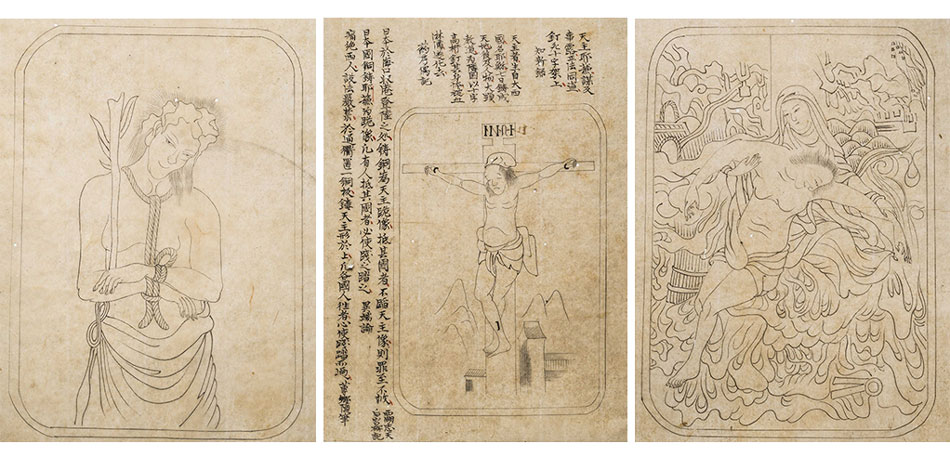Three Stations of the Cross Fumi-e

Courtesy of More Partnerships
Ink on Washi Paper, undated
Previously the priest had always been keenly interested in the Japanese--in their appearance, in their clothing and so on; but now he could arouse no interest within himself, such was his utter exhaustion. He simply closed his eyes and thought of the Stations of the Cross, one by one, now being prayed at some monastery; and he kept moving his dry tongue as he tried to mutter the words of the prayers. This was a prayer well known to all seminarians and Christians, a meditation calling to mind the details of the Passion of Christ. When this man had gone out through the gate of the Temple up the sloping path to Golgotha bearing his cross, struggling for every step and reeling as he walked, the swelling mob, all agog with curiosity, had followed after him. “Women of Jerusalem, weep not for me but for yourselves and your children. For the day will come . . .” These words came up in his mind. Many centuries ago, that man tasted with his dried and swollen tongue all the suffering that I now endure, he reflected. And this sense of suffering shared softly eased his mind and heart more than the sweetest water.
“Pange lingua...” He felt the tears streaming down his cheeks. “Bella premunt hostilia, da robur fer auxilium.” No matter what happens never will I apostatize, he said to himself.
- Silence, Shusaku Endo
These three images are drawings of bronze fumi-e in use during the 1660s in Japan, during the time of the persecution. Each of these drawings mirrors actual brass fumi-e portraying Stations of the Cross, which are held in the collections of the Tokyo National Museum.
The content of the text printed in the one image seem to indicate, however, that these images are drawn from a Chinese Buddhist perspective. The text refers to Christian beliefs as rebellious, heretical, and incorrect. It also describes the test of the fumi-e, which requires unforgivable sin (the denial of Christ by stepping on the image). It reports Christian believers being crucified in extreme agony, in the same way as the Jesus from the West.
The text and images reveal tension between Asian and Western cultural values. The Stations of the Cross represented in the fumi-e are marked in a traditionally Western way—the Ecce Homo, the Pieta, etc., yet make use of some indicators of Japanese context, almost as parody.
In the passage here, Silence shows a similar tension. Rodrigues powerfully experiences the Stations of the Cross as a way to manage the suffering of his capture, but his imagination of the Stations is a retreat from the people he came to serve. He reverts to Latin. Later in the book, in a conversation between Rodrigues and the authorities, the cultures seem to be at an impasse.
“Father,” said the Lord of Chikugo, “you and the other missionaries do not seem to know Japan.”
“And you, honorable magistrate,” answered the priest, “you do not seem to know Christianity.”
But Silence shows us that Rodrigues himself has much to learn about Christianity—about the Christ on the cross who matters not only “at some monastery,” but here in Japan. The fumi-e itself, and his engagement with one broken Japanese Christian, Kichijiro, teach him.